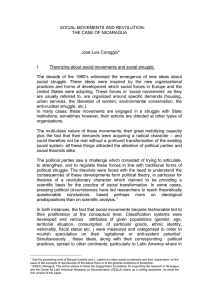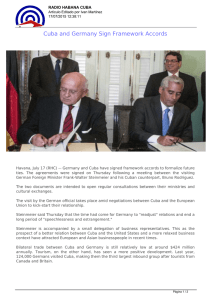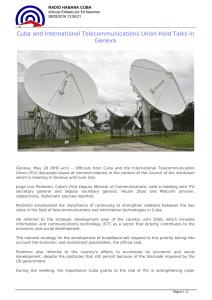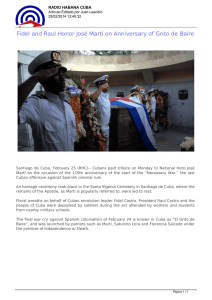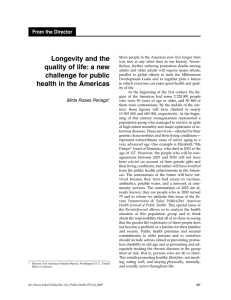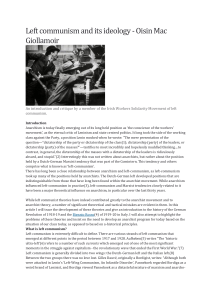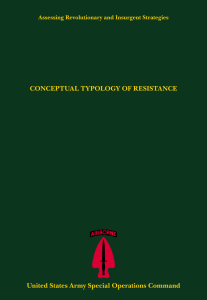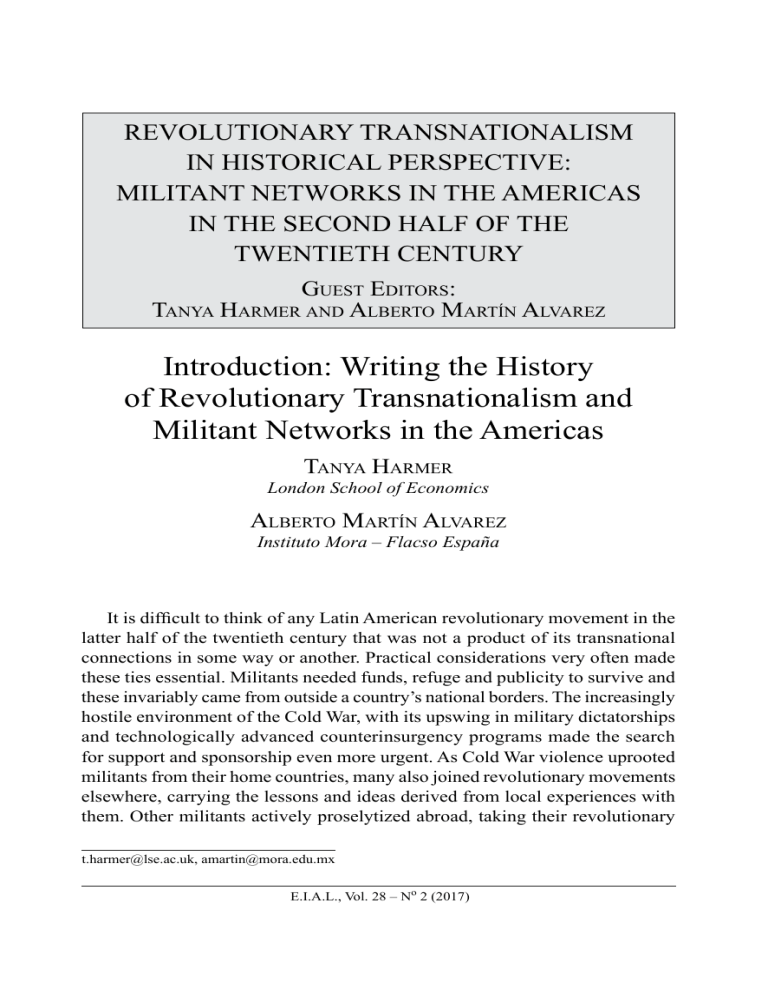
REVOLUTIONARY TRANSNATIONALISM IN HISTORICAL PERSPECTIVE: MILITANT NETWORKS IN THE AMERICAS IN THE SECOND HALF OF THE TWENTIETH CENTURY Guest Editors: Tanya Harmer and Alberto Martín Alvarez Introduction: Writing the History of Revolutionary Transnationalism and Militant Networks in the Americas Tanya Harmer London School of Economics Alberto Martín Alvarez Instituto Mora – Flacso España It is difficult to think of any Latin American revolutionary movement in the latter half of the twentieth century that was not a product of its transnational connections in some way or another. Practical considerations very often made these ties essential. Militants needed funds, refuge and publicity to survive and these invariably came from outside a country’s national borders. The increasingly hostile environment of the Cold War, with its upswing in military dictatorships and technologically advanced counterinsurgency programs made the search for support and sponsorship even more urgent. As Cold War violence uprooted militants from their home countries, many also joined revolutionary movements elsewhere, carrying the lessons and ideas derived from local experiences with them. Other militants actively proselytized abroad, taking their revolutionary t.harmer@lse.ac.uk, amartin@mora.edu.mx E.I.A.L., Vol. 28 – No 2 (2017) 8 E.I.A.L. 28–2 cause across borders, serving as armed insurgents and internationalists. In turn, transnational ties – both forced and voluntary – provided inspiration and intellectual nourishment for nationally or locally framed movements. In at least three instances – that of the Caribbean Legion, the Junta Coordinadora Revolucionaria (JCR) and the Batallón América – revolutionary militants also established explicitly transnational regional organizations. Indeed, such was the nature of revolutionary transnationalism in Latin America during the mid to late twentieth century, that separating different movements into neatly delineated national spaces can be an arbitrary and ahistorical exercise. Revolutionaries very rarely imagined their worlds as existing alone and separate from broader regional and global processes even if their identities and objects were originally national or original in scope. And yet historicizing and understanding the origins, operational practices, evolution and consequences of transnational revolutionary ties and influences can also be immensely difficult. As organizations dedicated to overthrowing the state, revolutionary groups were clandestine and secretive by their very nature – often on the run and engaged in covert maneuvers to avoid detection. They did everything to hide their plans rather than expend time on preserving historical archives and explaining the intricacies of their operations. More often than not, they communicated in code and destroyed messages after they were safely delivered. Records of revolutionary operations generally served a specific propagandistic purpose. The systematic repression and targeting by security services also meant that many revolutionaries died, taking their ideas, training and contacts with them to the grave. Cuba’s Revolutionary regime meanwhile continues to hold most of its historical records under lock and key. Writing the history of revolutionary transnationalism and militant networks can therefore be a daunting and complex task. Oral history interviews and memoirs are key sources for reconstructing and understanding the past. Revolutionary movements’ publications, communiqués and instruction manuals – where they exist – are fundamental. Security and intelligence services’ surveillance of militants can also help. But, ultimately, transnational history involves transnational research, expertise and sensitivity to the past as scholars track their subjects’ trajectories across space and time. Bringing together the fruits of such labors, this special issue provides valuable new insight into Latin American militant networks in the latter half of the twentieth century. Although it focuses broadly on revolutionary transnationalism in “the Americas,” one of its primary goals is to probe and rethink the spatial geographies of regional networks and transnationalism. As Aldo Marchesi argues in his article, examining the sub-regional area of the Southern Cone has a specific logic and historical rationale given the “deep regional dialogues” and physical movement of individuals that occurred in the 1960s and 1970s. Rather Introduction 9 than only revolutionary ideas, what determined the way in which revolutionary movements and militant networks evolved were the shared set of experiences and “regional exchanges” within the Southern Cone, in addition to the strategies and practices that were projected onto local and national contexts from beyond the Southern Cone either from Europe or Cuba. These exchanges took place in cafes, at universities, in print and in secret. And their protagonists shifted from capital city to capital city in pursuit of safe spaces as the wave of authoritarian dictatorships closed in around them. The Americas as a frame of reference was significant to the groups he talks about but not as immediately relevant as the more intimate experiences and interactions between militants in the Southern Cone itself. Marchesi’s work also highlights the importance of the Southern Cone as a focal point for the production of ideas and political strategies that circulated globally and were adopted and reinterpreted by organizations of the revolutionary left on a global scale. From the concept of the urban guerrilla warfare developed by the Tupamaros that was later adopted by left-wing armed groups in Europe and the United States, to the prominent contribution of the Dependency Theory to the updating of anti-imperialist thinking, the Southern Cone made crucial contributions to the political culture of the revolution on a global scale. As Marchesi himself points out, during the Long Sixties the Global South played an active role in generating ideas and repertoires of action, this being a significant moment in contemporary history in which innovations of global reach in the political arena emerged outside of the First World. Like Marchesi’s sub-regional focus, Aaron Moutlon’s study of the Caribbean Legion’s anti-fascist activists and Miguel Angel Reyes’ examination of cross-border ties between Andean insurgents similarly underline the significance of more specific transnational zones of contact and exchange within the Americas that we need to consider. Mostly, these cases show that geographical proximity helped determine the scope of such spaces. When militants were forced into exile or to seek refuge and rear-guard support, it made sense that they looked to move close by, hopeful that they might return home soon or have the means of affecting change in their home country more effectively. But the maps of specific revolutionary networks can also defy the cartographical shapes that we are familiar with. As Reyes shows, the links between the M-19 and AVC not only brought Ecuador, Colombia together, but also included Nicaragua, El Salvador and Libya in an intimate zone of interaction, training and exchange. When it comes to the Southern Cone countries that Marchesi examines – and more specifically the capital cities that attracted militants – the particularities of the environments and moments in time in which revolutionaries operated is also intriguing. Relatively open political systems, hospitable regimes and institutional support – for a brief period at least – led cities like Montevideo and Santiago to 10 E.I.A.L. 28–2 become political laboratories and hotbeds for evolving revolutionary strategies, utopian projects and progressive thinking. This particular spatial centralization of revolutionary networks during of a pivotal period had far-flung ramifications and consequences. Whether it came to theories of urban guerrilla warfare or Dependency Theory, revolutionary ideology and repertoires evolved directly from the specific context militants faced and their experience of fluid interaction and exchange. Grasping the nature of these contexts and chronological turning points in the history of revolution is important for advancing our understanding of revolution in the latter half of the twentieth century. The transnational encounters that took place in Guatemala City between 1944 and 1954 or Nicaragua in the years of the Sandinista government, as demonstrated by Moulton and Eudald Cortina respectively, for example, similarly stand out as significant spaces and moments for the history of revolution in the Americas – and beyond. Certainly, for the Argentines that lived and participated in Nicaragua’s revolution, Cortina argues, the experience of transnational activism changed their lives, shaping their ideas about identity and revolution, not to mention their strategies for future action and existence. However, first and foremost in facilitating transnational encounters and exchanges was Cuba. And one way or another, all the articles in this special issue engage with the significance of the Cuban Revolution, its reach and its influence as an unparalleled force in the latter half of the twentieth century. The island provided refuge for militants, as well as logistical support and institutional structures that shaped the history of revolution throughout the Americas. As a transformative political event, the revolution of 1959 itself – like the Haitian Revolution or the French Revolution before it – had a profound impact beyond its borders directly and indirectly among sympathizers and opponents alike. A major goal of this special issue is thus to examine and chart Cuba’s influence over time and space, and also to place it in context. Dirk Kruijt’s exceptional access to those who worked at the Departamento de las Americas and the extensive chronological sweep of his article offers a broad periodization of the Cuban revolutionary regime’s involvement in the Americas. In doing so, it shows the significant shifts and changes that occurred over time in the way Havana’s leaders conceptualized and executed their revolutionary operations. Kruijt also reveals the combination of individual personalities and institutionalized structures that underpinned the island’s ability to project itself abroad. Together with other articles here, and by exploring the spread of ideas, repertoires of action and militant memories that the Cuban Revolution encouraged, he thus adds to and builds upon our existing understanding of the mechanics and processes by which Cuba’s revolutionary regime interacted with movements and peoples, the extent to which this mattered and why. And yet, crucially, Moulton’s article Introduction 11 serves to contextualize Cuba and remind us that revolutionary transnationalism – albeit with different ends and characteristics – existed before 1959. By tracing the precursors to Castro’s first revolutionary ventures abroad after sweeping to power, he shows very clearly that they were rooted in a longer historical trajectory of sub-regional militant networks and transnational activism. Perhaps more importantly, he reminds us that Castro’s 26 July Movement received essential support from Caribbean Legionarios and the Auténticos who had participated in anti-fascist networks in the immediate aftermath of World War II. As he argues, the Cuban Revolution “would both inherit and challenge the structures and ideals of previous decades” thereby pushing us to rethink continuity and change across different revolutionary groups and contexts. The longer-term historical roots of the revolutionary left that we associate with the period after 1959 are also clear in insurgent groups’ reference to Simón Bolivar, as Reyes reminds us, although these broader historical contexts need further probing in the future beyond the specific contexts he examines. A final goal of this special issue is to question what all these transnational encounters and evolving revolutionary ideas, repertoires and memories amounted to. There is a general tendency among scholars of the transnational and global turns to romanticize and celebrate connectivity and movements of people and ideas across borders wherever they occurred. Historiographical trends and concerns have heightened this tendency. In an era of rising nationalism fetishism for fortified border walls and immigration curbs, there is also good reason for the tendency. Even so, as these five articles demonstrate, militant networks were very often as much about division and the exclusion of others as they were about inclusivity and hybridity. The formation and reformation of different networks and revolutionary “repertoires of contention” (Marchesi) often occurred in opposition to other groupings or responses to failed efforts to bring about change. Kruijt’s study of Cuba’s revolutionary operations in Latin America reminds us how prolific the splits, divisions and differences were between different revolutionary movements, not to mention the choices that Havana’s leaders made when deciding which groups to support. Cortina’s study of different Argentine revolutionary groups’ involvement in Nicaragua also underlines the different networks, processes, mechanisms and outcomes by which transnational activism occurred. Experiences were varied rather than uniform, and invariably, involvement with other militants and differences over what this meant or how to interpret what they were doing, why and with what consequences led to further divisions down the line. The desire to be part of a proceso común therefore paradoxically often had a tendency to drive militants apart. Similarly, the history of the Batallón América – formed on 20 December 1985 between Colombia, Ecuadorian and Peruvian guerrillas was destined to split apart before long. 12 E.I.A.L. 28–2 The JCR was decimated by security services before it got off the ground. The question is why: why did revolutionary transnationalism so infrequently lead to deeper ties and solid militant networks? Why did efforts to project revolutionary projects across regions – as opposed to nations – fail repeatedly over the latter half of the twentieth century? Where did revolutionary transnationalism yield the most significant rewards? As these articles suggest, perhaps the most enduring results of revolutionary transnationalism were tangents to the intended goals of the militants who forged them. The intellectual outputs of the Dependentistas in Chile who provided a new ideological underpinning for the revolutionary left in the late 1960s and 1970s radically altered the social sciences in privileged academic circles throughout the Americas but did not overturn the dependent system that it grappled with. And rather than overthrowing governments, the evolution of Cuba’s internationalism and transnationalism has led the Cubans to collaborate with them more to deliver essential medical services that states cannot provide. To understand the rise of Dependency Theory and the way it is taught on campuses around the world or Cuba’s medical humanitarianism is impossible without understanding the roots of far left revolutionary interactions that took place in the late twentieth century. But to celebrate networks and transnational ties as ends in themselves or intentionally designed to bring about such outcomes is to fundamentally misunderstand and misrepresent the ambitions and practices of the militants who shaped them There is admittedly still much to learn. Despite the advances in our understanding of revolutionary transnationalism, as demonstrated so well by the five articles in this special issue, far more research needs to be undertaken – either by individual scholars or collaboratively to excavate the history of revolution and networks in the America. For example, we know comparatively little about transnational ties and networks among rank and file militants. Elites and leaders were necessary conduits and vectors for revolutionary transnationalism. All five articles in this special issue show how pivotal individuals and personal relationships were in building networks. Contingency and personality mattered. But what about grassroots followers and members of revolutionary movements? Or the way that other sectors of the population understood them and their ideologies, repertoires and actions? Marchesi goes furthest here in placing the revolutionary networks themselves in a broader perspective, incorporating their interactions with journalists, academics and mass communication. Yet, we need to know more about the reception of transnational influences, transformative political events abroad and militant networks at a more local level to get a sense of their resonance and broader significance. The five articles here have focused on the networks and encounters themselves, but looking ahead, the next step will be to ask how they infused culture, popular imagination and identities beyond this. Introduction 13 For now, as editors of this special issue, we hope to have provided valuable new insight into revolutionary transnationalism and to have generated a series of questions for further research. We want to thank the British Academy’s Newton Mobility Grant, the École des Hautes Études Hispaniques et Ibériques (Casa de Velázquez) and the LSE’s Research Committee RIIF Seed Fund for their generous help in funding two conferences on global and transnational histories of Latin America's Revolutionary left. These conferences, organised between the LSE and Instituto Mora in 2016, inspired this special issue. We also want to thank the contributors and the editors of EIAL for their help in facilitating this ongoing and fruitful discussion.

